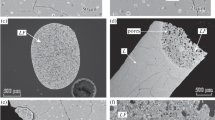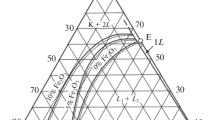Abstract.
Experiments to define the critical curve for a series of silicate melts in equilibrium with a hydrous fluid were carried out in a hydrothermal diamond anvil cell. Silicate compositions studied were albite with several wt% excess Na2O, B2O3 and F2O–1. Complete miscibility between melt and water was observed at lower pressure and temperature conditions compared to pure albite for all compositions. For albite + excess Na2O, the critical curve had been lowered by 143 and 247 °C at 10 kbar for 5 and 10 wt% excess Na. For albite +5 and 10 wt% F, the difference at 10 kbar was 147 and 246 °C respectively, and for albite +5 and 10 wt% B differences of 168 and 262 °C were found. These results are likely to be additive, with the presence of more than one of the components depressing the critical curve to even lower temperatures and pressures. The results suggest that in complex pegmatitic systems, complete miscibility between melt and fluid may be important in the final stages of crystallisation. The unusual properties of fluid phases under conditions close to the critical curve in a silicate melt–water system may be essential for the enrichment of trace elements in pegmatites as well as for the formation of typical pegmatite textures.
Similar content being viewed by others
Author information
Authors and Affiliations
Additional information
Electronic Publication
Rights and permissions
About this article
Cite this article
Sowerby, J.R., Keppler, H. The effect of fluorine, boron and excess sodium on the critical curve in the albite–H2O system. Contrib Mineral Petrol 143, 32–37 (2002). https://doi.org/10.1007/s00410-001-0334-5
Received:
Accepted:
Issue Date:
DOI: https://doi.org/10.1007/s00410-001-0334-5




